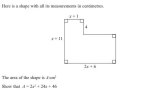EEPhil
Number 28
According to the on-line version of the local rag "'Impossible' maths exam question stumps parents" (Well 75% of parents and 100% of pupils) https://www.nottinghampost.com/news/nottingham-news/impossible-maths-exam-question-stumps-7972521
The question that is so impossible is:

That is so easy. Even with my maths being rusty and my memory failing me at times, it took less than 30s to solve this. (And no, I didn't look at the spoiler at the bottom of the article). Is it thick pupils or poor teaching, or both? No wonder we're in such a mess.
The question that is so impossible is:

That is so easy. Even with my maths being rusty and my memory failing me at times, it took less than 30s to solve this. (And no, I didn't look at the spoiler at the bottom of the article). Is it thick pupils or poor teaching, or both? No wonder we're in such a mess.




